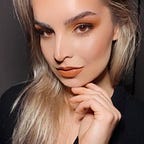‘’How To…’’ Colour Correct like a PRO…
When you hear the phrase ‘colour correct’, what do you think of? Do you automatically think of makeup or scrapbook crayons?
It’s ok if you thought of a different answer, I did too. haha!
Colour correcting was a huge trend changer in 2016.
Simply, colour correcting is ‘correcting’ discolouration to the skin.
The way in which you would use a C/C, is by neutralising the discoloured area with a ‘complimentary’ tone.
The range of colours in correcting include;
- orange/peach/cream
- green/mint
- yellow/warm vanilla
- purple/lilac
- red
- pink
Another way to understand HOW to use certain colours for specific skin area’s, is also by using the ‘problem’ tone that you want to fix, example; If you had dark/dull circles around the eye, you would then use the opposing colour pigment and place that over the area.
Here is a visual example. As said above, under the eye area. If you have a purple-toned under eye area, you would then go in and use the opposite shade; Orange-yellow.
(QUESTION): WHAT AREA’S OF THE FACE CAN C.C BE USED FOR?
- Rosacea
- dark circles (under the eye)
- dullness in the skin (cool toned skin)
- enlarged pores
- darkness in the skin
- acne
Not only can you use a C.C on your face.. you can even use it on your body. If you have an un-announced mark on your body, pop the opposing tone to that discoloured area.
(QUESTION): IS THERE MORE THAN 1 C.C FORMAT I CAN GET?
Yes of course. Colour correctors can come either on its own in a cream form OR combined in with another product. Example:
Shown above, are some of the forms that colour correcting formulas come in; face primers, concealers, foundations.
You can even use your concealer to colour correct, just use it sparingly over the discoloured area.
If you’re not sure where to buy a C.C from, your local makeup/grocery store would supply a product or two :)
(QUESTION): WHAT CHEAPER ALTERNATIVE/S CAN I USE?
Every now and then, colour correctors can be worth a bit more than you can buy, mainly because of the name on the bottle. You can however use the makeup you already have at home.
You know that coral/peach toned lipstick you have? — Pop that on your face. It works. As it has the similar creamy-consistency to the C.C’s, you can use your lipstick.
When I say lipstick, I mean ‘lipstick’, not lipGLOSS or lipBALM ;)
Colour correctors alternatives can also be found in any ‘2 in 1’, ‘3 in 1’ multipurpose skin products (you can check the description on the packaging).
Tinted moisturisers can also be another cheaper alternative. Lightly coating your face in with a tinted moisturiser will give your skin an enhanced natural-glow.
(QUESTION): DO I NEED SPECIFIC TOOLS TO USE C/C?
Like all makeup products, you can use either a specified makeup tool or you can use your finger tips. Why? — because the warmth in your finger tips will help melt the product onto the skin, giving you that seamless/blended effect.
If you wanted to use a makeup brush, make sure that the bristles are synthetic. As the product will applied more onto the face and not seeping into the bristles :)
Okie dokie.. thank you so much for checking out my latest blog post.
As always, if you have any questions or enquiries, send me a message on this platform OR over on my other social media platforms:
Instagram: @nikki.c.photography
Facebook: www.facebook.com/nikki.cross95
❤ ❤ ❤
